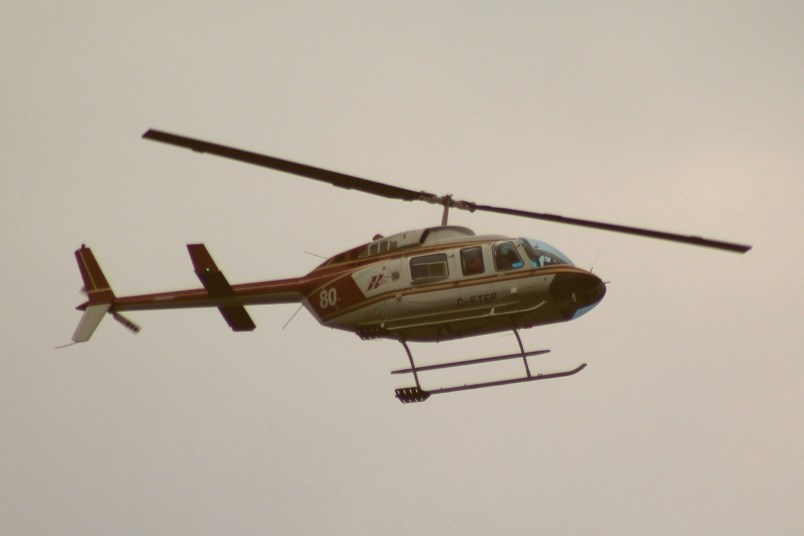Fire danger in the north is declining but several fires larger than 10,000 hectares continue to burn in the bush around the community. Many of the larger fires have been burning for nearly a month.
Most of northern Manitoba and Saskatchewan is, as of August 9, at a “low” fire danger according to Natural Resources Canada. The only exception is the area around Denare Beach, which is ranked as having a “medium” fire danger.
While the low fire danger is good news, evidently the fires themselves haven’t got the memo - all the blazes burning around Flin Flon and other nearby communities are still going as of The Reminder’s press time.
In Saskatchewan, the ALIR fire is still burning on Amisk Lake’s western shore, one full month after the fire was first reported on July 11. The fire has grown from a small, lightning-caused blaze to an inferno that has burned about 16,000 hectares of forest and brush. About 14,000 of those hectares are still considered to be active fire area, according to Natural Resources Canada and the Saskatchewan Public Safety Agency (SPSA). The ALIR fire is still considered by the SPSA to be “not contained” as of August 9. There are no confirmed reports of injuries or property damage in the area - there are cabins along the Sturgeon Weir River and a cemetery located nearby. All the fire’s latest hotspots have been reported to the west of the area already impacted by the fire, away from the lake shore and further from Denare Beach.
The Hobb fire, located south of Hanson Lake, is about 10 to 15 kilometres away from the ALIR fire at its closest and has most recently been reported to be spreading to the south and north. Just under 5,000 hectares of land has been burned by the Hobb fire, with about 3,430 hectares considered to be active fire territory. Much like its larger next door neighbour, no property damage or injuries have been reported but the fire is still considered “not contained” by the SPSA. The Hobb fire is within five kilometres of the Foran Mining McIlvenna Bay property, one of the area’s most notable mine exploration projects. The Hobb fire has been spreading to the north over the past week, though growth appears to be slowing.
The Harding fire near Smeaton is also still burning a month after it was first found, now at a size of over 25,000 hectares with an overall perimeter area of over 30,000 hectares. No recent hotspots have been detected with the fire as of August 9.
A smaller fire, dubbed the Fitz fire by the SPSA, is still burning north of Cotteral Lake. That fire, about 109 hectares in size as of August 9, is listed by the agency as “ongoing assessment”.
The SPSA has reported 538 fires this year as of August 9. By contrast, the last five summers have seen an average of 255 fires at this point of the year. Well over twice as many fires have been reported this summer, compared to the average. Out of those fires, 123 are still active, with 12 listed as “not contained”.
Manitoba
The closest Manitoba fire to the Flin Flon area remains the WE038 fire, located about 30 kilometres north of Flin Flon, north of Kisseynew Lake. While the fire is still burning, it has not made much progress towards town in recent days - few new reported hotspots have been found with the fire in recent days according to Natural Resources Canada and NASA mapping. The fire has burned an area of around 12,900 hectares, with 11,434 hectares still burning as of press time.
Not all the news is good on the Manitoba side though, as three large fires are continuing to burn near Pukatawagan and Snow Lake – the WE064, WE032 and WE049 fires. Both the WE064 and WE032 fires are listed as “out of control” by Manitoba Conservation and Climate.and are under full response, while the WE049 fire is being “monitored”, with a modified response in use.
The WE064 fire is the largest of the three and, according to Natural Resources Canada, has burned across both sides of the railway heading into Pukatawagan in several areas. Recent hotspots have been found on both sides of the line. The fire has affected 54,000 hectares of area and is now about 19,000 hectares in size, about 15 kilometres from Pukatawagan at its closest point.
The WE032 fire near Snow Lake has burned almost 56,000 hectares, burning south of Burntwood Lake. Recent hotspots with the fire have been reported to the western side of the fire toward Guthrie Lake and File River. At its closest point, the WE032 fire is about 20 kilometres from the WE064 fire. Snow Lake is about 20 kilometres south of the fire’s southernmost point.
The third fire, the WE049 fire, has burned over 22,000 hectares and is burning to the southwest of Highrock Lake, directly north of the WE032 fire and directly east of both Pukatawagan and the WE064 fire. The WE049 fire is about 12,800 hectares in active size as of August 9.
In Manitoba, 147 fires are actively burning province-wide and 430 fires have been reported so far this summer. The province is prioritizing two fires in northern Manitoba – the NO045 fire north of Split Lake (4,300 hectares in active size, considered “out of control” on August 9, burning within 10 kilometres of Split Lake and located near Public Road 280), and the NO129 fire, about 10,700 hectares in size burning near Marcel Colomb First Nation by Lynn Lake and Public Road 391.
“Resources have been mobilized to address both of these fires. Both provincial roads have re-opened, however conditions may change depending on wind direction and burning conditions,” reads the latest fire report as of press time from Manitoba Conservation and Climate.




